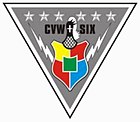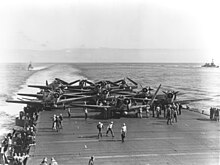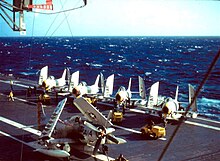Carrier Air Wing Six
|
Carrier Air Wing Six |
|
|---|---|

|
|
| active | July 1, 1938 to April 1, 1993 |
| Country |
|
| Armed forces | United States Navy |
The Carrier Air Wing Six (CVW-6) was a carrier wing of the United States Navy .
history
Between 1938 and 1992 there were three carrier squadrons No. 6 in the US Navy, the Enterprise Air Group from 1938 to 1942 , the Carrier Air Group Six (CVG-6) from 1943 to 1945 and the Carrier Air Wing Six (CVW-6 ) from 1943 to 1992 ) . The latter was from 1943 to 1946 as Carrier Air Group Seventeen (CVG-17) referred to, 1946-1948 as Carrier Air Group Five (CVBG-5) , 1948-1963 as Carrier Air Group Six (CVG-6) and 1963, to 1992 Carrier Air Wing Six (CVW-6) . It should be noted here that there is no continuation of traditional names in the American Navy, such as in the British Royal Navy . If a unit of the US Navy is set up under the same name, this is - at least officially - a completely new unit.
Enterprise Air Group
On July 1, 1938, the carrier squadron for the aircraft carrier Enterprise, which had been in service six weeks earlier, was set up. According to the practice at the time, it consisted of a fighter squadron (VF) with 20 Grumman F3Fs , a bomber squadron (VB) with 13 Northrop BT , a torpedo bomber squadron (VT) with 20 Douglas TBD and a reconnaissance squadron (VS) with 20 Curtiss SBC . Corresponding to the identification of the Enterprise , CV-6 (aircraft carrier no. 6), the squadrons were referred to as VF-6, VB-6, VT-6 and VS-6. However, the carrier squadron was referred to as the Enterprise Air Group .
At the time of the Japanese attack on Pearl Harbor on December 7, 1941, the Enterprise was about 350 km southwest of Pearl Harbor after it had brought fighters from the United States Marine Corps to Wake Island . Douglas SBDs were sent to Pearl Harbor to investigate and reached the island of Oahu during the attack . Six of them were shot down by the Japanese, two more Grumman F4Fs later by ardent Americans.
After the unsuccessful search for the Japanese attack force, aircraft of the Enterprise Air Group were able to sink the Japanese submarine I-70 on December 10th . After the rescue operation for the garrison on Wake was canceled , the Enterprise was used to protect the troop landings on Samoa in early 1942 . On February 1, the squadron's planes attacked Japanese bases on Kwajalein , Wotje and the Maloelap Atoll , losing one F4F and five SBDs.
In mid-April 1942, the Enterprise escorted the aircraft carrier Hornet , from whose flight deck 16 USAAF B-25 bombers took off on April 18, 1942 for (symbolic) bombing of targets in Japan ( Doolittle Raid ). Enterprise and Hornet then moved to the Southwest Pacific, but could not reach it in time for the battle in the Coral Sea .
Instead, they had been called back to Pearl Harbor to stop the impending Japanese attack on the Midway Islands , which had been detected by American radio reconnaissance. When the Battle of Midway began on June 4, 1942 , the American aircraft carriers Enterprise , Yorktown and Hornet were therefore in a favorable position so that the aircraft of the Enterprise carrier squadron could sink the Japanese aircraft carriers Akagi and Kaga , while those of Yorktown could sink the carrier Sōryū . Since the Yorktown itself had been badly damaged, the aircraft of the Yorktown Air Group were subordinated to the Enterprise . On the same day they were able to sink the last Japanese fleet carrier Hiryū and on June 6 the heavy cruiser Mikuma .
The Enterprise Air Group itself also suffered heavy losses, with a total of 10 TBD, 20 SBD and one F4F lost.
In July 1942, the squadron's squadrons were replenished and the outdated Douglas TBD torpedo bombers replaced with Grumman TBFs . From the beginning of August, the carrier squadron was used in the fighting around the Solomon Islands Guadalcanal . Together with the carrier squadrons of the aircraft carriers Saratoga and Wasp , the Enterprise Air Group supported the landings from August 7th. On August 24, the Enterprise was so badly damaged that it had to be repaired to Pearl Harbor without the squadron's planes being able to find the Japanese carriers. However, the VF-6 squadron was involved in the downing of approximately 40 Japanese aircraft while defending the Enterprise . After returning to Pearl Harbor, the Enterprise Air Group was dissolved, since the carrier squadrons were numbered from September 1942.
Carrier Air Group Six
On March 15, 1943, the Carrier Air Group Six (CVG-6) was reorganized. After the Enterprise was modernized from July to October , it was reassigned to this aircraft carrier. From November 19 to 21, 1943, the squadron's planes supported the landings on Makin Island , and on December 4 Kwajalein . In late 1943, the squadron left the Enterprise and was transferred to the Intrepid aircraft carrier . From January 16, 1944 to early February 1944, attacks were flown in support of the landings on Kwajalein . On February 17, the squadron was involved in Operation Hailstone , the attack on the Japanese Truk naval base . That night, the Intrepid was hit by a Japanese aircraft torpedo, so that it had to return to San Francisco . CVG-6 left the Intrepid shortly before entering the port on March 22, 1944. During the mission, CVG-6 was able to shoot down twelve Japanese aircraft, destroyed 42 on the ground and sunk five Japanese ships. The squadron lost nine aircraft, killing nine pilots and four crew members. The next deployment took place from March 1945 on board the aircraft carrier Hancock . From March 23 to 27, the squadron flew attacks on the Nansei Islands and Daitō Islands and Kyushu towards the end of the month. From April 1, the squadron supported the landings on Okinawa . On April 7, however, the Hancock was hit by a kamikaze airman . 62 crew members were killed and 71 injured and many of the squadron's aircraft were destroyed. The Hancock had to go to the USA for repairs and the squadron saw no more use until it was disbanded on October 29, 1945.
Carrier Air Group Seventeen
On January 1, 1943, the Carrier Air Group Seventeen (CVG-17) was set up. It was renamed Carrier Air Group Five (CVBG-5) on November 15, 1946 and Carrier Air Group Six (CVG-6) on July 27, 1948 . CVG-17 was used as a carrier squadron of the new aircraft carrier Bunker Hill of the Essex-class set up. It was the first squadron to receive the new Vought F4U Corsair fighter aircraft and the Curtiss SB2C Helldiver dive bomber . However, since the Corsair had problems landing, the VF-17 squadron was deployed from land and replaced by the VF-18 squadron equipped with Grumman F6F Hellcat . The squadron was first used on November 11, 1943 in an attack on the Japanese base Rabaul . Here VF-17 flew fighter protection from land over the Bunker Hill , while its own squadron flew the attack. From November 13th to December 8th, the squadron supported the conquest of the Gilbert Islands . On December 25th, January 1st and 4th Kavieng was attacked in the Bismarck Archipelago . From January 29 to February 8, 1944, CVG-17 took part in the conquest of the Marshall Islands . During the attacks on the Japanese Truk naval base on February 17 and 18, the squadron sank eight Japanese ships. After an attack on the Mariana Islands on February 23, the squadron left Bunker Hill to freshen up.
A training period in California followed from April to November 1944, with training missions being flown by the escort carrier Takanis Bay in August 1944 and by the ranger in October . Part of the squadron was again the VF-17 fighter squadron, but equipped with a Grumman F6F Hellcat. By January, the squadron was transferred via Pearl Harbor to the American fleet base in Ulithi with escort carriers Hollandia , Nassau and Kasaan Bay . From February 1 to June 13, 1945, the squadron was then used on the aircraft carrier Hornet . On 16./17. In February the squadron attacked targets in the Tokyo area , and from February 18-22 it supported the landing on Iwo Jima . From March 18 to June 3, attacks were flown on and around the main Japanese islands in preparation for the landing on Okinawa and support from April 1. The aircraft of the CVG-17 were involved in the sinking of the Japanese battleship Yamato on April 7, 1945 . CVG-17 left the Hornet on June 13, 1945 and returned to the United States on July 8.
On November 15, 1946, the squadron was renamed Carrier Air Group Five (CVBG-5) and used in 1947 and 1948 on the maiden voyages of the newly commissioned aircraft carriers Valley Forge and Coral Sea .
Carrier Air Wing Six
On July 27, 1948, it was finally renamed Carrier Air Group Six (CVG-6) , and on December 20, 1963, the squadron was renamed Carrier Air Wing Six (CVW-6) . As a squadron of the Atlantic Fleet , CVG-6 was mainly used in the Atlantic and the Mediterranean. In 1949 and 1951 there were two trips on the aircraft carrier Franklin D. Roosevelt , and four on the Midway from 1952 to 1954 . The mission in 1955/56 on Lake Champlain was the last of the squadron on a carrier without a sloping deck. From 1957 to 1962 the squadron was stationed on the Intrepid aircraft carrier for four missions . In August 1962, the squadron switched to what was then the largest warship in the world, the aircraft carrier Enterprise . In October of the same year the squadron was used to blockade Cuba during the Cuban Missile Crisis . Another mission to the Mediterranean followed in 1963. From July 31 to October 3, the squadron took part in Operation Sea Orbit , the first circumnavigation of the world by ships powered exclusively by nuclear power.
1965 to 1968 CVW-6 was then assigned to the aircraft carrier America . In April 1967 the America moved to Greek waters to be ready for evacuation measures that were not necessary after the military coup in Greece . In June 1967 the America was then deployed with the Saratoga in the western Mediterranean when the Six Day War broke out in the Middle East. CVW-6 helicopters were involved in the rescue operations for the American reconnaissance ship Liberty , which was mistakenly attacked by Israeli aircraft on June 8, 1967. From April 10 to December 16, 1968, the squadron was then used in the Vietnam War, with missions were flown 112 days. On July 10, 1968, pilots of the VF-33 Tarsiers fighter squadron were able to shoot down a North Vietnamese MiG-17 .
Between 1970 and 1975, the squadron then made five trips to the Mediterranean on the aircraft carrier Franklin D. Roosevelt . During the Yom Kippur War in October 1973, the Franklin D. Roosevelt was also in the Mediterranean. In support of Israel, the United States initiated Operation Nickel Grass , which provided Israel with massive airlift supplies. USAF transport aircraft flew from the US only over international waters and were escorted in the Mediterranean by the fighters of the carrier squadron CVW-1 (on the John F. Kennedy ), CVW-7 (on the Independence ) and CVW-6 . The carriers operated about 500 km apart, Independence being farthest east, south of the island of Crete , while the Franklin D. Roosevelt operated south of Sicily. In addition, the aircraft carriers also served as stopovers for A-4E Skyhawk fighter-bombers, which were handed over to Israel from stocks of the US Navy to compensate for the losses suffered.
1976 to 1978 CVW-6 was again stationed for two trips on the America . 1979 to 1985 the squadron then transferred to the aircraft carrier Independence for five missions, three of which also led to the Indian Ocean. At the end of October 1983, CVW-6 supported the US intervention on the Caribbean island of Grenada .
1986 to 1991 the squadron changed to the aircraft carrier Forrestal . In addition to operations in the Mediterranean and Indian Oceans, Forrestal also took part in the NATO maneuver Ocean Safari '87 in 1987 , which included a defense of Norway. At the beginning of December 1989, CVW-6 secured the summit meeting between US President Bush and the Soviet General Secretary of the CPSU Gorbatoschow in Malta. After returning from the last mission and the imminent decommissioning of the Forrestal in December 1991, it was also decided to deactivate the Carrier Air Wing Six as part of the reductions in the armed forces after the end of the Cold War . CVW-6 was decommissioned on April 1, 1992.
Identification and composition 1964
The US Navy has had a fixed system for identifying squadrons or squadrons ( Visual Identification System for Naval Aircraft ) since 1945 . Initially, this consisted of geometric patterns on the tail unit. The aircraft of the aircraft carrier Bunker Hill could be recognized by a white arrow pointing upwards, the Hornet by two white squares. However, since these were difficult to remember or to describe, letters were introduced as early as June 1945 to distinguish the squadrons. In 1957 the individual letters were replaced by doubles. In general, the squadrons of the Atlantic Fleet have an "A" as the first letter and those of the Pacific Fleet an "N". CVBG-5 and CVG-6 were recognized from 1946 to 1957 by the code letter (tail code ) C on the tail unit . 1957 to 1962 the aircraft of the squadron carried the tail code AF and 1963 to 1992 AE . The individual squadrons of the squadron are numbered in steps of 100, the aircraft of the squadron commander ( Commander, Air Group (CAG) ) can be recognized by the tactical number ending in "00".
For example, the following squadrons were part of the squadron during the 1964 mission and Operation Sea Orbit between February 4 and October 3, 1964 on the Enterprise :
| tactical number | Season | Aircraft type | Nickname |
|---|---|---|---|
| 100 | VF-102 | McDonnell F-4B Phantom II | Diamondbacks |
| 200 | VF-33 | Vought F-8E Crusader | Tarsiers |
| 300 | VA-66 | Douglas A-4C Skyhawk | Waldos |
| 400 | VA-64 | Douglas A-4C Skyhawk | Black Lancers |
| 500 | VA-65 | Douglas A-1 Skyraider | Tigers |
| 600 | VA-76 | Douglas A-4C Skyhawk | Spirits |
| 700 | VAH-7 | North American A-5A Vigilante | Peacemakers of the Fleet |
| GE 800 | VAW-12 DET. 65 | Grumman E-1B tracer | Bats |
| GD 8xx | VAW-33 DET. 65 | Douglas EA-1F Skyraider | Night Hawks |
| GA 900 | VFP-62 Det. 65 | Vought RF-8A Crusader | Fighting Photos |
| HU 00 | HU-2 Det. 65 | Kaman UH-2A Seasprite | Fleet Angels |
| xx | VRC-40 Det. 65 | Grumman C-1A Trader | Rawhides |
Web links
- Site from Japan with comprehensive information on squadrons and squadrons (English)
- United States Naval Aviation 1910-1995. (No longer available online.) In: history.navy.mil. US Naval Institute, archived from the original on October 15, 2014 (English, table of contents; PDF documents for download).
Individual evidence
- ↑ Stefan Terzibaschitsch : Aircraft carrier of the US Navy , p. 345
- ↑ http://www.cv6.org/1942/marshalls/marshalls_2.htm
- ↑ http://www.cv6.org/1942/doolittle/doolittle.htm
- ↑ http://www.cv6.org/1942/midway/default.htm
- ↑ http://www.ibiblio.org/hyperwar/USN/ships/logs/CV/cv6-Midway.html
- ↑ http://ibiblio.org/hyperwar/USN/USN-CN-ESolomons/
- ↑ http://www.wa3key.com/cv11data.html
- ↑ a b USS Bunker Hill (CV 17). (No longer available online.) In: chinfo.navy.mil. Archived from the original on March 2, 2009 ; accessed on March 16, 2019 (English).
- ↑ http://vt17.com/timeline.html
- ↑ http://gonavy.jp/CVW-AEf.html
- ↑ USS America (CV 66) ( Memento from April 27, 2009 in the Internet Archive )
- ↑ http://aupress.maxwell.af.mil/saas_Theses/colella/colella.pdf pp. 45-52
- ↑ USS Forrestal (CVA 59) ( Memento from April 16, 2009 in the Internet Archive )
- ↑ http://www.history.navy.mil/content/dam/nhhc/research/histories/naval-aviation/pdf/app23.pdf











